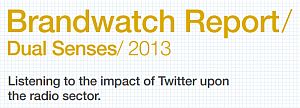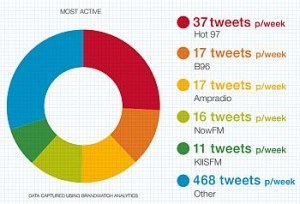 A new BrandWatch report studies how radio stations use Twitter, and which social tactics yield the best engagement with listeners. The report’s overall tone is negative and instructional. Radio stations lag behind TV shows in social savvy, and often leave social gains on the table through either lack of awareness, or lack of effort.
A new BrandWatch report studies how radio stations use Twitter, and which social tactics yield the best engagement with listeners. The report’s overall tone is negative and instructional. Radio stations lag behind TV shows in social savvy, and often leave social gains on the table through either lack of awareness, or lack of effort.
A few key findings:
- Not in the conversation: Only 0.06% of radio listeners tweet about a radio station (much higher in the U.K.
- Ignoring the audience: Radio stations target most of their interactions to celebrities and brands, not listeners.
- It’s about the personality: A station’s followers are much (54%) more likely to interact with a DJ than with the station’s Twitter feed.
The study provides a social tutorial to broadcasters via data. One point is about reputation management. Most of the conversational tone around radio stations is positive, but the report mentions one interesting point — negative tweets about a station mostly go without response from the station, possibly further embittering the unhappy listeners.
 On the general question of engagement with listeners via Twitter, sports stations do it best within the confines of this study. That makes intuitive sense, as sports-oriented talk stations are more fan-engaged on the broadcast side. Outside of that sector, the report paints a dismal picture of radio’s direct engagement with listeners on Twitter.
On the general question of engagement with listeners via Twitter, sports stations do it best within the confines of this study. That makes intuitive sense, as sports-oriented talk stations are more fan-engaged on the broadcast side. Outside of that sector, the report paints a dismal picture of radio’s direct engagement with listeners on Twitter.
Another lesson: Stations with comparable audience sizes can have dramatically different Twitter engagement metrics. The study accounts for the disparity as an issue of Twitter programming. Stations which promote holidays, link to external content, run contests, and post behind-the-scenes pictures harvest much higher social engagement.
Volume is as important as style in the context of this report. Stations that tweet more get sharply higher levels of audience tweets.
The study concentrated on 20 major-market radio stations across several programming genres. The social analytics were collected in June, July, and August.
A PDF of the report is available here.
